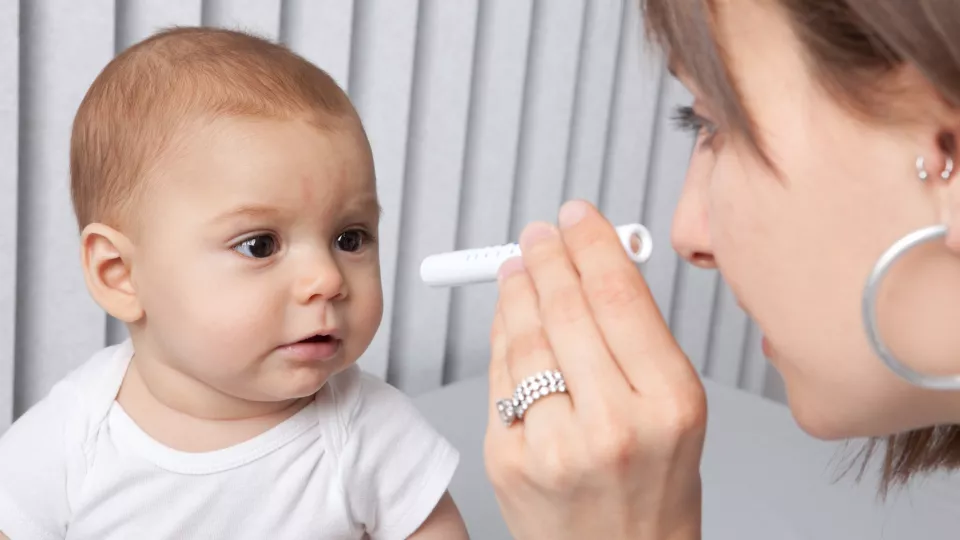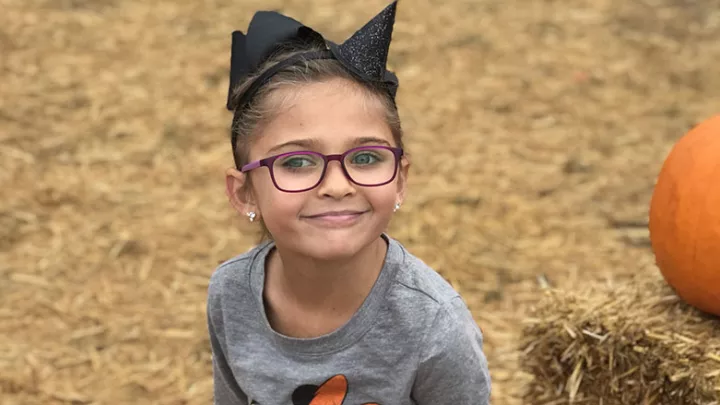
Helping Your Baby’s Eyes Develop
When a newborn opens their eyes for the first time, new parents wonder, “What exactly does my baby see?” Melinda Chang, MD, Attending Physician in the Vision Center at Children’s Hospital Los Angeles, explains what you can do to help—and protect your baby’s eyesight.
Help Your Baby’s Eyes During Pregnancy
“During your pregnancy what mainly matters is getting appropriate prenatal care and regular checkups with your doctor,” says Dr. Chang. This means:
- Maintaining healthy nutrition.
- Not smoking, as it increases the risks of premature birth and bacterial meningitis, both of which can lead to vision loss for your baby.
- Avoiding drugs and alcohol.
- Before taking any new medications, over-the-counter drugs, or even herbal therapies, discuss them with your OB/GYN.
- Take a daily prenatal vitamin as recommended.
- See your doctor if you experience any signs of pregnancy-related high blood pressure—a condition called pre-eclampsia. Symptoms include blurriness, double vision, temporary vision loss, unusual light sensitivity, and seeing flashing lights or new specks (sometimes called “floaters”).
What Your Baby Can See at Birth
At first, your newborn baby will not see much, as the eyes and brain are still maturing. “An infant’s vision is still quite blurry,” says Dr. Chang. If your newborn does not gaze at your face at first don't be discouraged. Within weeks, they will begin to look directly at you. If your baby is born prematurely, measure your infant’s vision milestones from their due date, not the date of birth. An ophthalmologist should examine your baby’s eyes if:
- Your baby was born prematurely.
- They show signs of eye disease.
- There is a family history of eye disease.
Your baby’s eyes are sensitive to harmful UV rays from the sun. Babies may be too small to wear sunglasses but protect them with a sunshade or a hat when outside. “It is normal for babies to be light-sensitive, but if they are excessively bothered by light that could be a red flag to see an eye doctor,” says Dr. Chang.
The pediatrician will examine their eyes and test for “red reflex.” A bright light shown in the eye should show a red reflection from the blood vessels. A white reflex could indicate a rare kind of eye cancer called retinoblastoma, or another eye problem that requires urgent treatment such as a cataract. This white reflection may also show up in photographs.
The first few months
Your baby’s central vision is still developing in the first months as the connections between the eyes and the brain mature. Infants begin to be able to move their focus from one object to another without moving their heads. Their eyes may still look unfocused or crossed but that will change as they gain visual coordination and start to follow objects with their eyes and reach for things. “By two months, if they're not fixating on your face and tracking objects and movements with their eyes, then I would be concerned," says Dr. Chang.
Other red flags can include abnormal eye movements that persist beyond 4 to 6 months of age. “If they squint their eyes shut in the light or try to turn away and seem averse to the light, that could be a sign of a retina problem,” says Dr. Chang. “If they poke at their eyes a lot, that could be a sign that they can’t see very well.”
By the fifth month, your baby should be developing visuomotor skills. They are better at reaching for and grabbing objects.
Between 6 and 12 months
A second vision screening should be done in the first year of life. Your baby’s pediatrician will inspect their eyes and check for healthy eye alignment, and how well your child can visually track moving objects.
By the time your baby is 12 months old, their eyes will likely have changed into their final color, but eye color can still deepen or change in the first three years of life. If the eye color is different between the two eyes, this could be a sign of a genetic condition, and you should seek a consultation with an eye doctor.
12 to 36 months
Your pediatrician will continue to perform age-appropriate vision screening throughout childhood. Your child may undergo a photo screening test, which checks eye alignment and the need for glasses. As your child gets older, your pediatrician may check your child’s vision using an eye chart.
Keep in mind as your child grows
If your pediatrician finds that your child has any of these conditions, see an ophthalmologist. Early treatment could lessen the condition. Children’s eye issues can include:
- Misaligned eyes (strabismus)—when one eye looks straight forward and the other turns in another direction. Strabismus, which affects about 4% of children in the U.S., can be treated with surgery.
- Lazy eye (amblyopia)—where one eye cannot focus properly, is weaker and has poor vision. Lazy eye is not helped by surgery but can be treated with glasses, eye patches, and other interventions up to age 7 to 8. If left untreated, the affected eye will always stay weak as the child grows, even if the correct glasses are worn.
- Refractive errors (myopia, hyperopia, astigmatism).
- Blockage of the tear drainage system, which can cause eye discharge and infections.
- Cataracts, when the lens of the eye is cloudy, prevent normal visual development.
- Cerebral/cortical visual impairment (CVI), when the visual pathways in the brain are damaged by neurologic conditions such as decreased oxygen to the brain.
- Genetic disorders that affect the retina or optic nerve.
- Eye problems associated with genetic conditions such as Down syndrome or neurofibromatosis.
- Side effects of certain medical treatments—for example, children who receive steroids may develop cataracts of glaucoma (high pressure in the eye).

